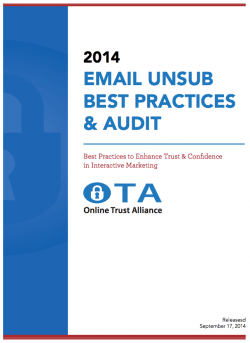Email is a vibrant channel for marketers to connect with consumers on many fronts providing an important value exchange between consumers and industry. Marketing emails can range from promotional offers and shipping confirmations to user surveys and distributing information tailored to users’ needs and interests. At the same time many consumers are faced with inbox overload ranging from spam and malicious email to excessive email not aligned to their interests.
Consumers often react negatively to email which they perceive as being irrelevant or sent too frequently. Today ISPs and mailbox providers are placing added weight on user engagement including open rates, click through and spam complaints. Combined with related anti-spam technologies, email authentication and heuristics, this data is used to make a determination on the placement of email into the user’s inbox, junk, spam folder or outright blocking.1 With these added considerations, it is more important than ever that marketers create a trustworthy unsubscribe mechanism for their recipients. The opt-out function should be easily discoverable, easy to operate and ensure a user’s request to be removed from a list is completed without delay.
Recognizing a decade has passed since CAN-SPAM was signed into law and in response to ongoing concerns about email marketing practices, in May 2014 OTA issued a public call for comments soliciting input into email marketing and unsubscribe best practices with the goal to move beyond regulatory requirements to one of user-centric stewardship.2, 3
Reflecting feedback from submitters in North America, the European Union, New Zealand and Australia, OTA created a list of best practices and initiated a study evaluating their adoption focusing on the top 200 ecommerce brands. The objective is to benchmark unsubscribe practices and provide actionable advice to the marketing community. Third and most important is to aid consumers, empowering their ability to control their inbox, enhancing trust and confidence in email marketing.4
Based on OTA’s research and unsub test criteria, 90% of the top ecommerce brands are in compliance with U.S. and Canadian unsubscribe regulatory requirements. Whereas 10% failed to have functional unsubscribe link or unsubscribe users within 10 business days. Surprisingly the audit revealed nearly 70% are significantly committed to user-centric best practices scoring 80% or better and 10% achieved 100% compliance with the top ten best practices (See page 12 for the list of Unsub Honor Roll recipients).
Brand owners and consumers alike should review these findings which in part reflect an organization’s commitment to consumers. Combined with other security and privacy enhancing best practices as outlined in OTA’s 2014 Online Trust Audit,5 consumers should consider these findings when using online services, shopping and banking online.
OTA calls on the marketing community to support these practices, demonstrating a commitment to the long-term integrity of interactive marketing and enhance consumer trust. With a focus on the users’ needs, the long-term benefits will be enhanced brand reputation, improved deliverability of legitimate email and resulting click-through. Combined the adoption of these best practices will help alleviate calls for added regulatory oversight while distancing legitimate marketers from spammers.
1 https://otalliance.org/resources/email-security
2 http://www.ftc.gov/enforcement/rules/rulemaking-regulatory-reform-proceedings/can-spam-rule
3 http://www.canadianadvertisinglaw.com/anti-spam-law/ & http://nnovation.com/blog/category/casl/
4 The scope of this report is focused on first party marketers and did not delineate between “Senders” and “Initiators”. In such cases separate links are a best practice as it allows a recipient to opt-out from the publisher/affiliate they desire OR opt-out from the actual brand because the user is not interested in the brand’s products or services.
